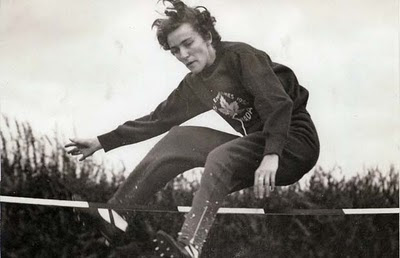This photograph depicts Dan MacLure in his car for hire touring a couple around Stanley Park in 1911. MacLure started a namesake cab company still in business today.
Special to The Globe and Mail
September 29, 2011
A tattered photograph, long ago bent in half and the upper corner torn away, depicts a cab driver in cap and uniform at the wheel of an open vehicle. In the rear sit two passengers in their Sunday best.
The hand-written caption reads, “Seeing Stanley Park in 1911.”
The driver is Donald Campbell MacLure, known as Dan, who would go on to own a service station, a motor-boat service, and a fledgling airline. His lasting contribution to Vancouver’s history is his name, which to this day appears in Coca-Cola script as part of the familiar blue-and-white livery of MacLure’s Cabs.
The oldest taxi company in the Lower Mainland will celebrate its 100th birthday next week with a private party at which a 1911 Cadillac is to be displayed alongside a Toyota Prius. The music will be provided by the Dal Richard Orchestra, which is appropriate since the one-man taxi company was barely six years old when the band leader was born.
Reporters have a soft spot for hacks, who, after all, know the location of every speakeasy and bootlegger in town. Cab drivers are also always good for a quote, sometimes even speaking the words which are attributed to them.
Taxis are useful, but they’re a service that seems to generate lots of complaints.
Unclean. Unsafe. Cheaters. And that’s just the passengers.
We’ve all had rides with drivers who seem as moody and paranoid as Travis Bickle.
The local taxi industry has a checkered history.
While trying to break a printers’ strike in 1946, management at the Daily Province hired Diamond Cabs to distribute a paper produced by non-union labour. In later years, taxi drivers were fired for trying to form a union.
At the airport, the battle over lucrative fares threatened to spill into violence among drivers from rival companies. Passengers complained of being refused entry if their destination was too nearby.
In 1975, the first plastic shield, imported from New York and strong enough to stop a .38-calibre bullet, was installed in a Yellow Cab to protect the driver from his passengers.
In the city’s post-war years, cabbies took part in plenty of stunts. Radio disc jockey Jack Cullen broadcast one of his famous Owl Prowl shows from a Black Top cabbed parked at a drive-in restaurant. Yellow Cabs held a Most Handsome Driver contest in 1950. The winner, Bud Veale, was a dead ringer for Hollywood movie star Van Johnson.
In those days, drivers had a reputation of doing anything for a passenger. In 1954, Dave King of B.C. Radio Cabs was driving a young woman to West Vancouver. When slowed by traffic on the Lions Gate Bridge, she jumped out. To the driver’s horror, she began climbing the railing. He raced over, hauling her to safety before escorting her into his car. Then they returned to her West End address. The would-be suicide paid her fare, he later told police, even tipping him 50 cents.
While Dan MacLure was an early cabbie, he was not the city’s first, an honour that possibly belongs to William Hayward. The hotel proprietor owned a White Steamer, manufactured in Cleveland at a sewing-machine factory. In 1904, the car could be hired for jaunts around the city by dialing 284 — the city had fewer than 1,000 telephones.
The other contender for the title of the city’s first cabbie is Charles Henry Hooper, an adventurer who raced cars against the famous Barney Oldfield, rustled cattle in the Cariboo and mined for gold in the Klondike. Handsome Harry, as he was known, drove a wheezy, two-cylinder Ford Model A. For a time, he earned his living as a professional cyclist, touring Canada with a dog called Dirty Face.
As part of its centenary celebration, MacLure’s will be adding the phrase “Serving Vancouver since 1911” to its fleet of 65 vehicles. The company changed hands several times after the 1953 death of the founder and is currently known as MacLure’s Cabs (1984) Ltd., a 27-year-old company marking a centenary.
So, happy 100 years to the Vancouver taxi industry.
I know it only seems I’ve been waiting that long for my car.
Dan MacLure's name still appears on a Vancouver cab company a century after he began as a driver for hire.
Only four Vancouver companies remain in a business that once counted dozens of rival firms. MacLure’s claims to be the oldest, followed by Yellow, which started in 1921. Black Top and Checker Cabs was started by eight veterans returning from the Second World War. Vancouver Taxi launched in the 1980s to provide service to handicapped customers only.
In 1910, the first motor taxi company appears in the Vancouver city directory. Columbia Taxicab was owned by E.H. Heaps, a businessman who also had timber interests.
By the boom years of the late 1920s, the city had dozens of rival taxi companies, names that have mostly disappeared from the public memory. There was ABC Taxi and BB Taxi; Fifty Cent Taxi and Fred’s Dollar Taxi; Frisco and Hollywood; Owl and Sun; Canadian and Dominion; Commercial and Webster’s Peerless; Devonshire and Kerrisdale; Mikado and Nabata; Queens and Empress and Royal City; Ready and Roamer; De Luxe and Gold Band.






















